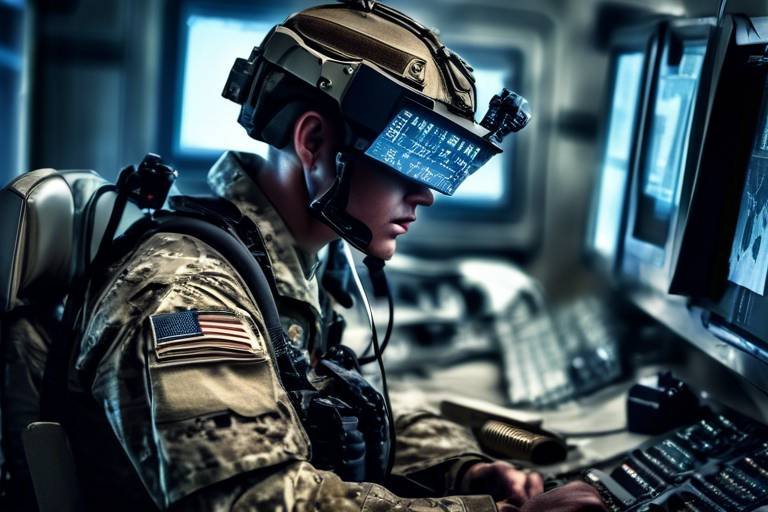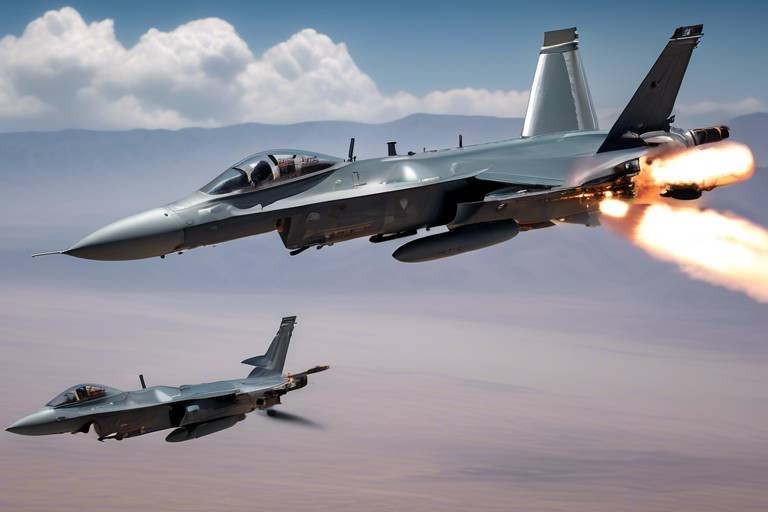The Significance of Open Source Intelligence in Modern Warfare
In an age where information is as powerful as weaponry, understanding the significance of Open Source Intelligence (OSINT) in modern warfare is crucial. Imagine being in a battlefield where the line between victory and defeat is often drawn by the quality and timeliness of information. OSINT, which refers to data collected from publicly available sources, has transformed military operations by providing critical insights that were once the domain of classified intelligence. This article explores the multifaceted role that OSINT plays in contemporary military strategies, operational planning, and national security, revealing how it has become an indispensable tool in the arsenal of modern armed forces.
One of the most compelling aspects of OSINT is its accessibility. Unlike traditional intelligence methods, which often rely on covert operations and classified information, OSINT can be gathered from a variety of sources, including social media, news articles, public records, and satellite imagery. This democratization of information allows military forces to tap into a wealth of data that can inform decision-making and enhance situational awareness. As we delve deeper into the applications and implications of OSINT, it’s clear that this intelligence discipline has not only changed the way wars are fought but also how they are anticipated.
As we navigate through the complexities of modern warfare, the role of OSINT becomes even more pronounced. With the rapid evolution of technology and the proliferation of information, the ability to analyze and interpret vast amounts of data is crucial. Military planners and strategists must now consider not only the traditional battlefield but also the digital landscape where information flows freely. This shift has significant implications for how nations prepare for conflict, respond to threats, and engage in strategic planning.
OSINT is not without its challenges, however. The sheer volume of information available can lead to information overload, making it difficult to discern what is relevant and credible. Additionally, the reliability of publicly available data can vary widely, raising concerns about the accuracy of intelligence derived from such sources. Despite these obstacles, the benefits of OSINT far outweigh the challenges, as it provides a comprehensive view of the operational environment that can enhance military effectiveness.
As we look to the future, the integration of advanced technologies such as artificial intelligence (AI) and machine learning into OSINT practices is set to revolutionize military intelligence operations. These innovations promise to streamline data collection processes, improve analysis capabilities, and ultimately lead to more informed decision-making. The potential for OSINT to evolve alongside technological advancements highlights its significance in maintaining national security and strategic advantages in an increasingly complex global landscape.
- What is Open Source Intelligence (OSINT)? OSINT refers to information collected from publicly available sources, such as social media, news articles, and public records, which can be utilized for military and strategic purposes.
- How does OSINT differ from traditional intelligence methods? Unlike traditional intelligence, which often relies on classified information and covert operations, OSINT is gathered from open and accessible sources, making it more versatile and timely.
- What are the main challenges associated with OSINT? The main challenges include information overload, credibility issues regarding the sources of information, and the potential for misinformation.
- What role does technology play in OSINT? Technology, especially AI and machine learning, enhances OSINT by improving data collection, analysis, and interpretation, making military operations more efficient.

Understanding Open Source Intelligence
Open Source Intelligence, commonly referred to as OSINT, represents a critical component of modern intelligence gathering that relies on information sourced from publicly available materials. Unlike traditional intelligence methods that often depend on classified or proprietary information, OSINT thrives in the realm of transparency and accessibility. This makes it an invaluable asset for military operations, allowing armed forces to harness a wealth of information without the need for covert operations.
At its core, OSINT encompasses a variety of data types, including but not limited to:
- Media Reports: News articles, blogs, and podcasts that provide insights into current events.
- Social Media: Platforms like Twitter, Facebook, and Instagram where individuals share opinions, sentiments, and real-time updates.
- Public Records: Government documents, legal filings, and other publicly accessible data.
- Academic Publications: Research papers and studies that can offer in-depth analysis on specific issues.
What sets OSINT apart from traditional intelligence methods is its openness. While traditional intelligence often involves espionage, surveillance, and other clandestine activities, OSINT relies on information that is freely shared and accessible to anyone with an internet connection. This difference not only democratizes the intelligence landscape but also poses unique challenges and opportunities for military strategists.
Moreover, the importance of OSINT has surged in recent years, particularly with the rise of digital communication and the vast amounts of data generated daily. In a world where information is abundant, the ability to sift through and analyze relevant data becomes paramount. Military operations can greatly benefit from OSINT by gaining insights into enemy movements, public sentiment, and potential threats without the risks associated with traditional intelligence methods.
As we dive deeper into the implications of OSINT, it is essential to consider its applications in real-world scenarios. For instance, during conflicts, military units can utilize OSINT to monitor social media for changes in public sentiment or to track the movements of opposing forces. This real-time intelligence can significantly enhance operational planning and situational awareness, allowing commanders to make informed decisions swiftly.
In summary, OSINT is not just a buzzword; it's a transformative approach to intelligence gathering that reflects the evolving nature of warfare in the digital age. As we continue to explore its role in modern military operations, we must also address the challenges and ethical considerations that come with it.
- What is Open Source Intelligence (OSINT)? OSINT refers to the collection and analysis of information from publicly available sources.
- How does OSINT differ from traditional intelligence? OSINT relies on open, accessible information, while traditional intelligence often involves classified methods.
- What are some common sources of OSINT? Common sources include social media, news articles, public records, and academic publications.
- Why is OSINT important in modern warfare? OSINT provides real-time insights, enhances situational awareness, and supports strategic planning without the risks of covert operations.

The Role of OSINT in Modern Warfare
In the dynamic landscape of modern warfare, open source intelligence (OSINT) has emerged as a game-changer. Unlike traditional intelligence methods that often rely on classified or restricted information, OSINT taps into the vast pool of publicly available data. This shift is akin to turning on the lights in a dark room; suddenly, the once-hidden details become visible, allowing military strategists to make informed decisions. But how exactly does OSINT fit into the military puzzle?
One of the most significant roles of OSINT is enhancing decision-making processes. In a world where information is constantly flowing, the ability to quickly analyze and interpret data can mean the difference between success and failure on the battlefield. Military leaders can leverage OSINT to assess enemy movements, understand public sentiment, and identify potential threats before they escalate. Imagine being able to predict an adversary's next move based on their social media activity or public statements—this is the power of OSINT in action.
Moreover, OSINT contributes to operational planning. By integrating open source data into their strategies, military forces can create more robust and adaptable plans. For instance, during a conflict, real-time updates from various sources can provide insights into the evolving situation on the ground, allowing commanders to adjust their tactics accordingly. This adaptability is crucial, especially when unexpected challenges arise. The ability to pivot quickly based on accurate information can turn the tide of battle.
Another critical aspect of OSINT is its role in maintaining situational awareness. In modern warfare, where conflicts can unfold rapidly, having a clear understanding of the environment is essential. OSINT allows military personnel to gather information from diverse sources, including news articles, blogs, and forums, giving them a comprehensive view of the operational landscape. This multi-faceted approach to intelligence gathering ensures that military forces are not only reacting to events but are also proactively shaping their responses.
To illustrate the impact of OSINT, consider the following table that highlights its various applications in military operations:
| Application | Description |
|---|---|
| Threat Assessment | Analyzing online discussions and news reports to identify potential threats. |
| Public Sentiment Analysis | Monitoring social media to gauge public opinion and morale. |
| Geospatial Intelligence | Using satellite images and maps to understand terrain and enemy positions. |
| Counterintelligence | Identifying misinformation campaigns and other deceptive practices. |
However, it’s essential to recognize that while OSINT offers numerous advantages, it is not without its challenges. The sheer volume of information available can lead to information overload, making it difficult for military analysts to discern what is relevant. Additionally, the credibility of sources can vary significantly, necessitating a rigorous verification process to avoid falling victim to misinformation.
In conclusion, the role of OSINT in modern warfare cannot be overstated. It serves as a vital tool for enhancing decision-making, operational planning, and situational awareness. As military forces continue to adapt to the complexities of contemporary conflicts, the integration of open source intelligence will undoubtedly play a crucial role in shaping the future of warfare.
- What is OSINT? Open Source Intelligence (OSINT) refers to the collection and analysis of information from publicly available sources.
- How does OSINT differ from traditional intelligence? Unlike traditional intelligence, which often relies on classified or restricted information, OSINT uses data that is accessible to the public.
- What are some examples of OSINT sources? Examples include social media platforms, news articles, blogs, government reports, and satellite imagery.
- What challenges does OSINT face? OSINT can encounter issues such as information overload, source credibility, and the potential for misinformation.

OSINT Collection Methods
In the ever-evolving landscape of modern warfare, the methods used to gather open source intelligence (OSINT) are as diverse as they are crucial. The ability to collect actionable information from publicly available sources can significantly influence military strategies and operational effectiveness. One of the primary methods of OSINT collection is through the analysis of social media. Platforms like Twitter, Facebook, and Instagram serve as treasure troves of real-time information. Military analysts can track trends, gauge public sentiment, and even identify potential threats by scrutinizing posts, comments, and hashtags. Imagine being able to predict a protest or a violent outbreak simply by monitoring social media chatter—this is the power of OSINT in action.
Another vital method involves the use of satellite imagery. This technology provides a bird's-eye view of geographical areas, enabling military forces to assess troop movements, infrastructure developments, and even environmental changes. With high-resolution images, analysts can pinpoint enemy positions and plan accordingly. For instance, if a military base is expanding, it could indicate preparations for an offensive operation. The ability to interpret these images can be a game-changer in strategic planning.
Additionally, public records also contribute significantly to OSINT collection. These records can include everything from government documents to business registrations and even property records. By piecing together information from various public databases, analysts can construct a comprehensive picture of a particular area or situation. For example, if a suspicious company is registered in a conflict zone, it may warrant further investigation. The combination of these methods allows for a multi-faceted approach to intelligence gathering.
Moreover, the rise of data mining technologies has revolutionized OSINT collection. Tools that analyze vast amounts of data can identify patterns and anomalies that would be impossible for humans to detect alone. This capability not only speeds up the collection process but also enhances the accuracy of the intelligence gathered. However, it’s essential to remember that while technology can assist in the collection of OSINT, human analysts are still crucial for interpreting this information and making informed decisions.
In summary, the methods employed for OSINT collection are varied and increasingly sophisticated. From social media analysis to satellite imagery and public records, each method plays a vital role in enhancing military situational awareness. As we continue to embrace technological advancements, the potential for more effective OSINT collection will only grow, reshaping the future of military operations.
- What is OSINT? Open Source Intelligence (OSINT) refers to information collected from publicly available sources, used primarily for intelligence purposes.
- How is social media used in OSINT? Social media platforms are analyzed to track trends, monitor public sentiment, and identify potential threats in real-time.
- What role does satellite imagery play in OSINT? Satellite imagery provides crucial geographical data, helping military forces assess troop movements and plan operations effectively.
- What are the challenges of OSINT? Challenges include information overload, credibility issues, and the need for skilled analysts to interpret the collected data accurately.

Social Media as a Tool
In the digital age, social media has emerged as a powerful tool for gathering open source intelligence (OSINT). Platforms like Twitter, Facebook, and Instagram are not just social networking sites; they are treasure troves of information that can provide invaluable insights into public sentiment, emerging threats, and even enemy movements. Imagine a battlefield where the lines of engagement are not just drawn on maps but are also reflected in the tweets and posts of individuals on the ground. This is the new reality of modern warfare, where social media analytics can significantly influence military strategies.
One of the most compelling aspects of using social media for OSINT is its immediacy. Information spreads like wildfire on these platforms, allowing military analysts to gain real-time insights into situations as they unfold. For instance, during conflicts, social media can reveal the mood of the local population, helping military leaders gauge potential uprisings or support for their operations. Moreover, by monitoring hashtags and trending topics, intelligence agencies can quickly identify areas of concern or interest. This capability is particularly useful in regions where traditional intelligence-gathering methods may be limited or too slow to react.
However, leveraging social media for intelligence purposes is not without its challenges. The vast amount of data generated daily can lead to information overload, making it difficult for analysts to sift through the noise and identify actionable intelligence. Additionally, the credibility of information sourced from social media is often questionable. Misinformation and propaganda can spread just as rapidly as legitimate news, potentially leading to misguided military decisions. Therefore, it is crucial for analysts to employ robust verification techniques to assess the reliability of the information they encounter.
To effectively utilize social media for OSINT, military organizations often employ a combination of automated tools and human analysts. These tools can scrape data from various platforms, filtering out irrelevant information and highlighting key trends. Once this data is collected, human analysts can interpret it, providing context and insights that machines alone cannot achieve. This blend of technology and human intuition is essential for making sense of the chaotic landscape of social media.
In conclusion, social media has transformed the way military forces gather intelligence. By tapping into the wealth of information available online, they can enhance their situational awareness and improve decision-making processes. As we move forward, the integration of social media into military operations will only deepen, shaping the future of warfare in ways we are just beginning to understand.
- How does social media contribute to OSINT? Social media provides real-time information and insights into public sentiment, allowing military analysts to make informed decisions based on current events.
- What are the challenges of using social media for intelligence? The main challenges include information overload and the credibility of the data, as misinformation can easily spread on these platforms.
- How do military organizations verify information from social media? They use a combination of automated tools for data collection and human analysts to interpret and verify the information's reliability.

Utilizing Satellite Imagery
In the realm of modern warfare, satellite imagery has emerged as a game-changing asset for military operations. Imagine having a bird's-eye view of the battlefield, where every movement and every change in the landscape is captured in real time. This technology is not just about pretty pictures from space; it’s about gathering actionable intelligence that can make or break a military strategy. Satellite imagery allows armed forces to monitor troop movements, assess damage post-engagement, and even predict enemy actions based on visual data.
One of the key advantages of using satellite imagery is its ability to provide detailed geographical insights. With high-resolution images, military analysts can identify critical infrastructure, such as bridges, supply routes, and bunkers, which are essential for planning operations. The ability to zoom in on specific areas of interest means that commanders can make informed decisions based on the most accurate information available. Furthermore, advancements in imaging technology have improved the clarity and detail of these images, allowing for better analysis and interpretation.
Moreover, satellite imagery plays a crucial role in enhancing situational awareness. In a conflict zone, understanding the terrain and the disposition of forces is vital. For instance, during reconnaissance missions, satellites can provide real-time imagery that helps in assessing the battlefield environment. This information can be pivotal in determining the best course of action, whether it’s launching an airstrike or deploying ground troops. The integration of this data into military operations has revolutionized how decisions are made, shifting from reactive to proactive strategies.
However, it’s essential to recognize that while satellite imagery offers numerous benefits, it also comes with its own set of challenges. The sheer volume of data generated can lead to information overload, making it difficult for analysts to sift through and extract meaningful insights. Additionally, the accuracy of the imagery can be compromised by factors such as weather conditions or technological limitations. Therefore, military organizations must continuously invest in training personnel and upgrading technology to maximize the effectiveness of satellite imagery.
In conclusion, the utilization of satellite imagery in military operations is a testament to how technology can enhance strategic planning and operational execution. As we look to the future, the integration of advanced analytics and artificial intelligence with satellite data will likely further transform how military forces operate, making them more agile and informed than ever before.
- What is satellite imagery? Satellite imagery refers to images of Earth taken from satellites orbiting the planet. These images can provide valuable data for various applications, including military operations.
- How does satellite imagery enhance military operations? It enhances military operations by providing real-time data on troop movements, geographical features, and potential targets, allowing for informed decision-making.
- What are the challenges of using satellite imagery? Challenges include information overload, accuracy issues due to environmental factors, and the need for specialized training to analyze the data effectively.
- Is satellite imagery used in civilian applications? Yes, satellite imagery is widely used in civilian applications, including agriculture, urban planning, disaster management, and environmental monitoring.

Challenges in OSINT Application
Open Source Intelligence (OSINT) has undoubtedly transformed the landscape of military operations, but it is not without its challenges. One of the most pressing issues is the phenomenon of information overload. With the sheer volume of data available on the internet today, military analysts can quickly become overwhelmed. Imagine trying to find a needle in a haystack, but the haystack is constantly growing! This situation can lead to critical information being overlooked or misinterpreted, which can have dire consequences in a military context.
Another significant challenge is credibility and reliability of the information gathered. Not all data available online is accurate, and misinformation can spread like wildfire, especially on social media platforms. For instance, a single tweet can spark panic or lead to incorrect military assessments. Analysts must be skilled at discerning the veracity of sources, which can be a daunting task. They need to ask questions like: "Is this source trustworthy?" and "What is the agenda behind this information?"
Moreover, the rapid pace of information dissemination can lead to a situation where intelligence becomes obsolete almost as soon as it is collected. In modern warfare, situations can change in the blink of an eye. A piece of intelligence that was relevant just moments ago may no longer hold any value as new developments unfold. This creates a constant race against time for military personnel to act on the information before it loses its strategic value.
Additionally, the legal and ethical implications of using OSINT cannot be ignored. As militaries delve deeper into publicly available information, they must navigate a complex web of privacy laws and ethical considerations. For instance, while social media platforms are rich sources of intelligence, they also harbor personal information that could infringe on individuals' privacy rights. The challenge lies in balancing the need for national security with the imperative to respect individual freedoms.
Finally, as technology advances, the tools and techniques for gathering OSINT are becoming increasingly sophisticated, but this also means that adversaries are enhancing their capabilities. This leads to a cat-and-mouse game where military forces must continuously adapt to counter new threats. For example, if a military unit employs advanced algorithms to analyze social media trends, adversaries may develop countermeasures to obfuscate their activities, making it even harder for intelligence agencies to operate effectively.
In summary, while OSINT offers a wealth of opportunities for enhancing military operations, it also presents a myriad of challenges that must be carefully managed. Addressing these issues is crucial for ensuring that open source intelligence remains a valuable asset in modern warfare.
- What is OSINT? OSINT stands for Open Source Intelligence, which refers to information collected from publicly available sources.
- What are the main challenges of OSINT? The main challenges include information overload, credibility issues, rapid obsolescence of data, legal and ethical concerns, and the evolving capabilities of adversaries.
- How can militaries ensure the reliability of OSINT? Militaries can ensure reliability by employing rigorous vetting processes for sources and utilizing advanced analytical tools to cross-reference information.
- What role does social media play in OSINT? Social media serves as a vital tool for gathering intelligence, monitoring public sentiment, and assessing potential threats, but it also presents challenges in terms of misinformation.

Legal and Ethical Considerations
As we delve deeper into the realm of Open Source Intelligence (OSINT), it becomes increasingly clear that the implications of its use extend beyond mere tactical advantages. The legal and ethical considerations surrounding OSINT are profound and complex, raising questions that challenge the very foundations of privacy, data protection, and the morality of intelligence gathering in warfare. In a world where information is at our fingertips, the line between public knowledge and invasive surveillance can often blur, leading to significant dilemmas for military and intelligence agencies.
One of the primary concerns is privacy. While OSINT relies on publicly available information, the sheer volume of data can lead to the unintentional exposure of personal details about individuals. For instance, social media platforms are treasure troves of data that can reveal a user's location, opinions, and even sensitive personal information. This raises the question: at what point does the collection of open source data infringe upon an individual’s right to privacy? The challenge lies in balancing the need for national security with the protection of individual rights, a task that is becoming increasingly difficult in our hyper-connected world.
Moreover, the credibility of the information gathered through OSINT is another critical issue. Unlike traditional intelligence methods, which often involve classified or verified sources, OSINT is susceptible to misinformation and propaganda. In military operations, relying on flawed data can lead to catastrophic decisions. For example, during conflicts, adversaries may disseminate false information to mislead military forces. Thus, intelligence agencies must implement rigorous verification processes to ensure the reliability of the data they collect.
| Legal and Ethical Challenges | Description |
|---|---|
| Privacy Concerns | The risk of infringing on individual privacy rights when collecting publicly available information. |
| Data Credibility | The challenge of ensuring the accuracy and reliability of information from open sources. |
| Data Protection Laws | Compliance with national and international regulations governing data collection and use. |
| Ethical Dilemmas | Balancing the need for intelligence with the moral implications of surveillance and data gathering. |
Furthermore, the legal frameworks governing OSINT can vary significantly across different jurisdictions. In some countries, stringent data protection laws dictate how information can be collected and used, while in others, there may be little to no regulation. This inconsistency poses challenges for multinational military operations, as forces must navigate a complex landscape of laws and ethical standards. For instance, what is permissible in one country may be illegal in another, leading to potential legal ramifications for intelligence personnel.
Ultimately, the ethical dilemmas faced by intelligence agencies when collecting OSINT are profound. As technology continues to advance, the methods of gathering intelligence will evolve, but the fundamental questions regarding the morality of surveillance and the protection of civil liberties will remain. Agencies must engage in ongoing dialogues with policymakers, legal experts, and the public to establish guidelines that respect individual rights while ensuring national security. This balance is not merely a legal obligation; it is a moral imperative in a democratic society.
- What is OSINT? Open Source Intelligence refers to the collection and analysis of information from publicly available sources.
- Why is privacy a concern in OSINT? The collection of publicly available information can inadvertently expose personal details about individuals, raising privacy issues.
- How can the credibility of OSINT be ensured? Agencies must implement rigorous verification processes to assess the reliability of the data collected from open sources.
- What legal challenges does OSINT face? Legal challenges include varying data protection laws across jurisdictions and the need to balance national security with individual rights.

Balancing Security and Privacy
In an era where information is as valuable as gold, the tension between national security and individual privacy has never been more pronounced. As governments and military organizations increasingly rely on open source intelligence (OSINT) for strategic advantage, the ethical implications of this practice raise serious questions. How do we ensure that our quest for security does not trample on the rights of individuals? This delicate balance is akin to walking a tightrope—one misstep could lead to either a security breach or a violation of civil liberties.
At its core, the challenge lies in the nature of the information gathered. OSINT often involves collecting data from publicly available sources, which can include everything from social media posts to satellite imagery. While this information can provide crucial insights into potential threats, it also means that the personal lives of individuals are under constant scrutiny. This situation leads to a pivotal question: where do we draw the line between surveillance for safety and invasion of privacy?
To navigate this complex landscape, intelligence agencies must adopt a framework that emphasizes transparency and accountability. Here are some key considerations:
- Data Minimization: Collect only the information necessary for a specific purpose to reduce the risk of misuse.
- Informed Consent: Whenever possible, individuals should be informed about how their data is being used.
- Oversight Mechanisms: Establish independent bodies to monitor intelligence activities and ensure compliance with laws and ethical standards.
Moreover, the role of technology cannot be understated. Advanced algorithms and machine learning can help filter and analyze vast amounts of data, allowing agencies to focus on relevant information while minimizing unnecessary intrusion into personal lives. However, the reliance on technology also raises concerns about bias and the potential for misuse. If the tools employed to gather intelligence are flawed, the consequences can be dire, leading to wrongful accusations or unjust actions against innocent people.
Ultimately, the question of balancing security and privacy is not just a legal or technical issue; it is a moral one. It requires a collective effort from governments, tech companies, and civil society to create a framework that respects individual rights while safeguarding national interests. The ongoing dialogue about these issues is essential, as it shapes the future of how we approach intelligence gathering in a world that is increasingly interconnected.
- What is OSINT? Open Source Intelligence (OSINT) refers to information collected from publicly available sources, such as social media, news articles, and public records.
- How does OSINT impact military operations? OSINT enhances situational awareness, aids in strategic planning, and informs decision-making processes in military operations.
- What are the ethical concerns surrounding OSINT? Ethical concerns include privacy violations, data protection issues, and the potential for misuse of information collected from individuals.
- How can we balance security with privacy? By implementing data minimization practices, ensuring informed consent, and establishing oversight mechanisms, we can strive to balance these two crucial aspects.

Future Trends in OSINT
As we gaze into the crystal ball of military intelligence, the future of Open Source Intelligence (OSINT) is both exciting and daunting. With the rapid evolution of technology, OSINT is poised to undergo significant transformations that could reshape the landscape of modern warfare. One of the most promising trends is the integration of artificial intelligence (AI) and machine learning into OSINT processes. Imagine a world where algorithms can sift through vast oceans of data, identifying patterns and extracting actionable insights in real-time. This capability could enhance decision-making speed and accuracy, giving military strategists a critical edge on the battlefield.
Moreover, the rise of big data analytics will revolutionize how intelligence is gathered and interpreted. With the ability to analyze massive datasets from various sources—including social media, news articles, and public records—militaries can gain a more comprehensive understanding of the operational environment. This shift from traditional intelligence methods to data-driven approaches will enable armed forces to predict trends, assess risks, and identify emerging threats with unprecedented precision.
Another noteworthy trend is the increasing reliance on geospatial intelligence (GEOINT). As satellite technology advances, the availability of high-resolution imagery will become more widespread, allowing for more detailed reconnaissance and surveillance. This data can be crucial for strategic planning, enabling military forces to visualize terrain, track movements, and assess infrastructure in real-time. The integration of GEOINT with OSINT will create a more holistic view of the battlefield, enhancing situational awareness and operational effectiveness.
However, with these advancements come challenges. The sheer volume of information generated can lead to information overload, making it difficult for analysts to discern valuable insights from noise. To combat this, future OSINT systems will likely incorporate advanced filtering techniques and automated processes to streamline data analysis. This evolution will not only improve efficiency but also reduce the cognitive burden on intelligence personnel.
Furthermore, as OSINT continues to grow in importance, the legal and ethical implications will become increasingly complex. Issues surrounding privacy and data protection will demand careful consideration. Military organizations must navigate the fine line between leveraging publicly available information for national security and respecting individual rights. The development of clear guidelines and ethical frameworks will be essential to ensure that OSINT practices align with democratic values and international law.
In conclusion, the future of OSINT is bright, with the potential to transform military operations fundamentally. As we embrace technological advancements, we must also remain vigilant about the ethical implications and challenges that accompany them. The ability to harness the power of open source information responsibly will be crucial for maintaining a balance between security and individual freedoms.
- What is OSINT? Open Source Intelligence (OSINT) refers to information collected from publicly available sources, including the internet, social media, and public records, which is used for intelligence purposes.
- How does AI impact OSINT? AI enhances OSINT by automating data analysis, identifying patterns, and providing actionable insights more quickly and accurately than traditional methods.
- What are the ethical concerns of using OSINT? Ethical concerns include privacy issues, data protection, and the potential misuse of publicly available information in military operations.
- Will OSINT replace traditional intelligence methods? While OSINT will complement traditional intelligence methods, it is unlikely to fully replace them. Instead, a hybrid approach combining both will likely be the norm.
Frequently Asked Questions
- What is Open Source Intelligence (OSINT)?
Open Source Intelligence (OSINT) refers to the process of collecting and analyzing information from publicly available sources. This includes data from social media, news articles, websites, and other accessible platforms. Unlike traditional intelligence methods, which often rely on classified or restricted information, OSINT leverages the vast amount of information available to anyone with internet access.
- How does OSINT impact modern military operations?
OSINT plays a crucial role in modern military operations by providing real-time situational awareness and aiding in strategic decision-making. It helps military leaders understand the battlefield environment, assess threats, and plan operations more effectively. By utilizing OSINT, militaries can make informed decisions based on current data, which can be a game-changer in fast-paced combat scenarios.
- What are some common methods for collecting OSINT?
There are several methods for collecting OSINT, including:
- Social media analysis to gauge public sentiment and monitor potential threats.
- Satellite imagery to gather geographical data and assess enemy positions.
- Public records and databases to obtain relevant information about individuals and organizations.
Each method has its strengths and can be used in various military contexts to enhance intelligence capabilities.
- What challenges does OSINT face in military applications?
Despite its advantages, OSINT encounters several challenges, such as:
- Information overload, where the sheer volume of data can be overwhelming and lead to analysis paralysis.
- Credibility issues, as not all publicly available information is reliable or accurate.
- Legal and ethical dilemmas surrounding privacy and data protection.
These challenges can significantly impact the effectiveness of OSINT in military operations.
- Are there legal and ethical concerns associated with OSINT?
Yes, the use of OSINT raises important legal and ethical questions. Issues include the potential invasion of privacy when monitoring public information, data protection laws that govern how information can be used, and the broader implications of employing such intelligence in warfare. Balancing national security needs with individual privacy rights is a critical concern for intelligence agencies.
- What future trends can we expect in the field of OSINT?
The future of OSINT looks promising with advancements in technology, particularly in artificial intelligence and machine learning. These technologies are expected to enhance data analysis capabilities, making it easier to sift through vast amounts of information quickly and accurately. As OSINT evolves, we can anticipate more sophisticated tools and methodologies that will further improve military intelligence operations.



















